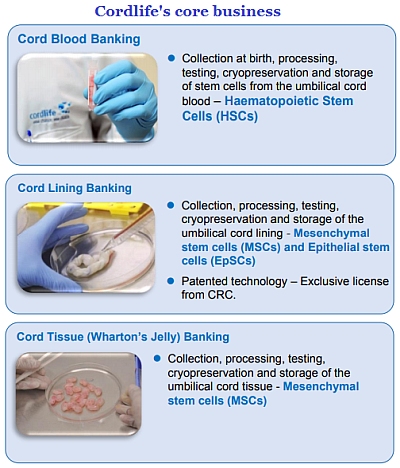The Covid-19 outbreak impacted Cordlife's 1H20 sales but net cash flow from operations stayed strong at S$6.7 million.
For perspective, Cordlife's market cap is S$92 million (stock price: 39 cents). The high cashpile represents 67% of the market cap. It "puts us in a very good position especially now if we want to take on either M&A or organic expansion," said CFO Choo Boon Yong at a 1H20 investor presentation. "Our low gearing of 3.2% enables us to access banking facilities or the capital markets if we need to. We may be able to pick up some assets during this period which will help us in our expansion." |
||||||||||||||||||||||||||
 Cordlife’s business not only generates high cashflow but also a good gross profit margin, which stayed stable in 1H20 at 62.7% (HY2019: 62.9%).
Cordlife’s business not only generates high cashflow but also a good gross profit margin, which stayed stable in 1H20 at 62.7% (HY2019: 62.9%).
The gross margin is a blended figure from various markets largely because Cordlife prices its services differently in different places.
Net profit margin was 10.0%, which also stood out from its performance of recent years.
|
(S$'m) |
1H 2020 |
1H 2019 |
Change |
|
Revenue |
26.2 |
30.1 |
(12.7%) |
|
Gross Profit |
16.5 |
18.9 |
(13%) |
|
Profit before tax |
3.1 |
2.8 |
11.1% |
|
Income tax |
(0.5) |
(1.1) |
(52.7%) |
|
Net Profit |
2.6 |
1.8 |
50.2% |
Revenue declined 12.7% y-o-y to S$26.2 million due to a decrease in new cord blood, cord tissue and cord lining samples processed and stored in 1H2020.
Demand for the Group’s banking services has been affected by the outbreak of COVID-19.
Cordlife noted that consumers were tighter with their spending, and in some regions, movement limitations and border restrictions have made service delivery even more challenging.
The business decline was partially offset by higher take-up of higher-value priced plans in Singapore and Philippines as well as increased revenue contribution from diagnostic services.
To overcome restrictions on physical marketing, Cordlife embarked on a slew of digital initiatives such as webinars where it could reach out to potential customers across countries.
This non-invasive testing is catered for expectant women in their first trimester. It analyses "cell free foetal DNA" in the mother’s blood to detect foetal chromosomal abnormalities using whole genome sequencing.  CEO Tan Poh LanIs the higher take-up of the test due to Covid-related concerns? CEO Tan Poh LanIs the higher take-up of the test due to Covid-related concerns?Cordlife CEO Tan Poh Lan replied that the test draws a blood sample and is the preferred alternative to amniocentesis which carries a small risk of puncturing the amnio sac surrounding a fetus, which could lead to a miscarriage. Cordlife has focused on growing this business segment by partnering doctors, for example, to offset the declining trend of new births in its target community (professionals) across its markets. Diagnostics contributed about 5% of group revenue. |
Group net profit after tax grew by S$0.9 million to S$2.6 million, mainly driven by:
| (a) lower marketing expenses of S$1.4 million (attributable to lower advertising and promotion activities due to the outbreak of COVID-19), (b) lower administrative expenses of S$1.1 million and (c) lower income tax expense (due to reversal of overprovision for prior year taxes and utilisation of tax losses carried forward). |
 CFO Choo Boon Yong Notably, Cordlife's 1H20 profit figure has not yet reflected the cash contribution from the Singapore government's Job Support Scheme (JSS) received in 1H20.
CFO Choo Boon Yong Notably, Cordlife's 1H20 profit figure has not yet reflected the cash contribution from the Singapore government's Job Support Scheme (JSS) received in 1H20.
"The recognition of JSS will be matched with the period we are expected to experience the economic impact from the circuit breaker. For Cordlife, the impact would come in 2H2020 given that baby deliveries normally happen 2-3 months after parents sign up for our banking services," said Mr Choo.
| In the banking business, given the long-running contracts undertaken by every client, how much of the revenue is "new" -- ie, derived from new clients -- versus recurring? Mr Choo said processing revenue makes up about 80% while storage revenue, 15%. Ms Tan added: "A big chunk of revenue is recognized in the beginning for processing because we do a lot more work in the beginning, a lot of testing is done." |
For the 1H2020 Powerpoint presentation, click here.





